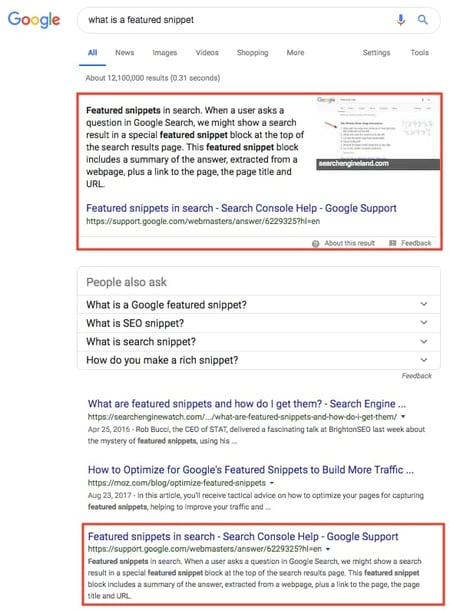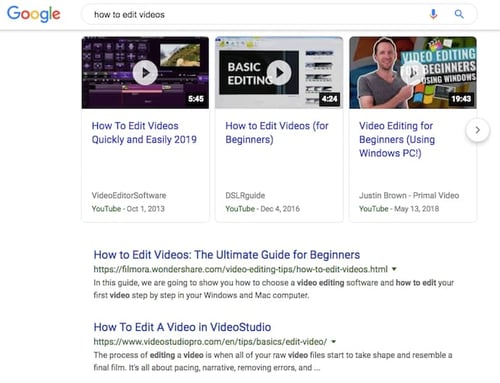Search results for: marketing strategies
Video Marketing
Local Marketing Made Easy Video Training
Local Marketing Made Easy
Your Google Rank Doesn’t Matter Anymore
For a long time, keyword rankings were a staple part of any SEO campaign. In a lot of cases they were a primary metric used to judge performance.
Today, your Google keyword ranking is just one of several reasons your traffic can increase or decrease.
Google Keyword Ranking
Google keyword ranking indicates where on Google’s search engine results pages (SERPs) an individual webpage is positioned when a user enters a keyword. Typically, 10 results comprise a SERP, and the higher your position on that SERP, the more organic traffic your webpage will get. Lately, however, there are other SEO variables marketers need to pay attention to.
Just six or seven years ago, we had so much more information on the keywords users were searching to reach our web content. All of this information was available transparently within Google Analytics, and you could get relatively accurate search volume estimates from within Google’s Keyword Tool.
>” src=”https://no-cache.hubspot.com/cta/default/53/bd685600-02f9-40f3-a4e7-18488a8d79ba.png”>
The first major update that changed this was Google’s move to encrypted search and the dreaded appearance of “not provided” within Google Analytics. This means you can no longer find out which keywords are bringing in the organic traffic your website is receiving. The “not provided” tag looks a little something like this:

This created a ripple effect across many SEO software providers that made a lot of their tools less effective — or at least tougher — to measure the impact coming from organic search on a granular level.
Google’s next major change — a more recent one — was its decision to move search volume estimate within their Keyword Planner tool to show estimates in broad ranges. Instead of learning that a keyword was being searched for 1,400 times each month, we’re told that it’s searched between 1k-10k times per month. This isn’t overly helpful when developing your content strategy.
These changes have forced marketers to adapt their search strategy to focus less on individual keywords and shift to a topic-centric content strategy, especially for content sitting at the top of their marketing funnel.
Keyword Rankings are Inaccurate
One of the major criticisms of keyword ranking data is the fact that it is largely inaccurate. Many industry leaders and even software providers of rank tracking data have admitted that this is the case.
The reasons behind this can be broken down into three broad buckets:
- Personalization.
- Device.
- Location.
Personalization
Around the time of the launch of Google+, the SEO industry was talking a lot about personalization within search. Even after the death of Google+, personalization has remained a big consideration.
Bonus points if you remember Authorship snippets (circa 2012).
Ultimately, Google will deliver results that are personalized to a user based on their search history. This means that if I were to search for a query like “electric cars” and I’d previously been browsing the Tesla website, it’s a possibility that Google would tailor the rankings of the search results to show Tesla near the top.
This wouldn’t be the case for someone that hasn’t previously visited Tesla’s website, which makes it very tough to determine which website actually ranks #1 (because it can be different from one person to the next).
Device and Location
Whilst personalization plays a part in the ambiguity of keyword rankings, it’s nothing compared to the role of implicit query factors like device and location.
One of Google major advancements in search over the past five years has been its ability to take into account aspects of a search query that aren’t explicitly stated. To make sense of what I’ve just said, let’s take a query like, “Boston restaurants”.
Go back to 2010 and a search for “Boston restaurants” would yield a list of relatively generic websites that either talk about Boston restaurants or maybe are a restaurant.
Fast-forward to 2018 and a simple search for “Boston restaurants” will arm Google with a whole lot more information than before. They’re able to see which device you’ve searched from, where you’re located whilst you’re searching, even if you’re currently on the move.
Let’s say that you searched on an iPhone and you’re walking around in the center of Boston at 11:30 am. Here’s what this query would actually look like to Google:
“Which restaurants are currently open for lunch within walking distance of my current location in the center of Boston, MA?”
They’ve gathered all of this information without the individual even having to type it. As a result, they’re able to completely tailor the search results to this individual searchers’ current situation.
So … to answer the question of who ranks #1 for “Boston restaurants” becomes an even more challenging task.
Keyword Rankings are Directional at Best
Strong keyword rankings don’t always equate to high volumes of organic traffic, let alone improvements in revenue. As I mentioned at the beginning, we’ve lost a lot of visibility on search volume metrics, which makes it very difficult to accurately estimate the amount of traffic you can gain from an individual keyword. Factor in the changing appearance of the search engine results page (e.g. the widespread increase in featured snippets) and it becomes an even more daunting task.
If keyword rankings are your North Star, you may be traveling in the completely wrong direction.
Here are three search features that can interfere with your keyword rankings while presenting you with opportunities to capture traffic from Google in new ways:
Featured Snippets
Featured snippets are the enhanced search results that appear at the very top of Google SERPs. They’re a form of “rich snippet,” a grouping of structured data that Google has collected from a webpage. And due to their size, they can take an extraordinary amount of traffic away from the the results beneath them.

What makes featured snippet results so important? Publishers can earn them regardless of their Google rank. That’s right, it is entirely possible for a site below position #1 on the SERP to win this top-dwelling space, making Google rank noticeably less important for topics that are vulnerable to them. Check it out below — as you can see, the featured snippet is pulling in a result that technically ranks in position 3, allowing it to steal organic traffic from the results in positions 1 and 2.
Videos
Video is playing an increasing part in content marketing strategies, and not for superficial reasons. Videos published to any platform, not just YouTube, are now ending up on SERPs where Google has determined the intent behind a search query is best served in this medium.

These video results might take away traffic from publishers, but they also allow you to “rank” for keywords you might not have written content to target.
Image Packs
Image packs are large groupings of images that Google pulls into its SERPs from the Images tab in a Google search. As you can see below, they can be so large that they take up all the space “above the fold” of a SERP. This makes results ranking in position 1 for a particular keyword hard-pressed to capture organic traffic from that keyword unless they’ve published images dedicated to (and optimized for) this keyword.

When all you’re obsessing over is where each page is tracking against a ranking goal, you’ll likely be misses a ton of other value that your content is bringing in. For example, what if you’ve built out some content with the primary goal of driving backlinks or social traffic, but it isn’t necessarily designed to rank for much itself (e.g. a research report)? Using keyword rankings as a determining factor of success could evaluate content in a completely inaccurate way.
Measuring Performance at the Topic Cluster Level
To combat a lot of the issues I raised above, we shifted the way that we measured content at HubSpot. For the past couple of years we’ve taken a step back from analyzing the performance of content on a page-by-page level and looked at the performance of content at the topic cluster level.
Organic search traffic and conversions are our primary search goals, so when we group our content into clusters to try and gain visibility for any searches related to a given topic, we look at the collective performance of these groups of webpages vs just the performance of individual pages.
This model of analysis helps us account for the varying goals of each individual piece of content. Also, running this analysis at scale tells us which topics tend to drive more traffic growth compared to others, and which topics tend to convert traffic at a higher rate.
This information tends to provide much clearer insights for the team as to what they should focus on next without obsessing over individual keyword rankings.
Is There Still a Place for Keyword Rankings?
Despite everything I’ve said above, I’m not actually saying that keyword rankings are dead (I can already see the tweets ready to be fired at me!). Keyword data can be useful for digging into any SEO problems that happen to your site, and also to look into the intent behind certain types of searches.
That said, the new version of Google Search Console that has just recently been rolled out should give you pretty much everything you need here.
More than anything, as a marketer you need to be aware that the data that you’re looking at related to keywords is not 100% accurate. As a result, this should never be your primary performance metric.
![]()
Burn your social media strategy

I recently came across an amazing post that I urge everyone to read about the current state of social media.
Burn It Down, Start From Scratch And Build a Social Media Strategy That Works
Here is just an excerpt – this is towards the end of the long post. Please, please do yourself a favor and read the whole thing. Then read it again. Then print it and pass it around. And then change everything you’re doing.
DOING SOCIAL MEDIA RIGHT
Most companies are doing social wrong and have done it wrong from the beginning. The key to success is to stop most of what today passes for social media strategy and rebuild social plans from the ground up:
- First, create and measure a new definition of WOM. An individual who recommends your brand based on their actual customer experience is gold; a customer who clicks the “heart” button on a pretty photo posted by your brand isn’t even tin (and a like that is bought is a stain on the soul of your brand). Now is the time to recognize that not all consumer interactions are equal and to succeed, brands must generate the WOM that matters–not the activities that are easy to manipulate and tabulate but the ones that are difficult and meaningful. Discard the fake WOM strategies created with brand-to-consumer content broadcasted in social channels and focus on the real WOM forged peer-to-peer with customer stories, recommendations and advocacy. Fake WOM gets people to click “like” on something the brand posted; real WOM gets people to tell others why they should trust, try and buy your product or service.
- Toss out your social media scorecard immediately. The first step to refocus social activities on what matters is to change what is measured. Stop rewarding employees or agencies for generating engagement that fails to deliver business benefit and start measuring what matters–changes in customer loyalty or consideration, positive and authentic Word of Mouth, inbound traffic that converts, quality lead acquisition and customer satisfaction.
- Reconsider what department should lead your social media efforts. Once you have reconsidered the metrics that matter, the next question is who within the organization is best equipped and staffed to deliver on those metrics. If organic social media is not proving an effective marketing channel, should your marketing team be responsible for content creation and managing social media calendars? If one-to-one engagement and responsiveness are the new goals, which department is best staffed to provide what the brand needs and consumers expect in social media? These are vital questions, because whichever department funds and manages social media will expect the outcomes and use the metrics about which they most care. A recent report from Econsultancy makes the case: Among Financial Service firms, just 38% see social media as a channel for retention; the majority sees it geared for acquisition and cross-sell. That means most of these firms are using social media to chase marketing strategies to drive sales (an approach we now know will fail) while the minority have social media strategies designed to improve customer satisfaction, reputation, loyalty and retention–goals generally not associated with Marketing but with Public Relations and Customer Care departments.
- Objectively assess the return your brand generates with content marketing in social channels, and stop what is not working. If you are not today validating positive return on marketing content posted to social channels, you certainly will not do so in the future as organic reach crumbles to nothing. Marketers continue to act as if content marketing is destined to work and they have simply failed yet to find the right content marketing strategy. Data tells us otherwise; customers and prospects inundated with marketing messages, distrustful of brand content and protected behind social paywalls and adblocking software are not interested in or available to your content marketing output. Content is essential and has a place in Marketing strategies, but now is the time to rebalance the investment the brand is making to match the return it receives and can expect.
Read the rest. You won’t regret it.
The post Burn your social media strategy appeared first on Social Fish.


